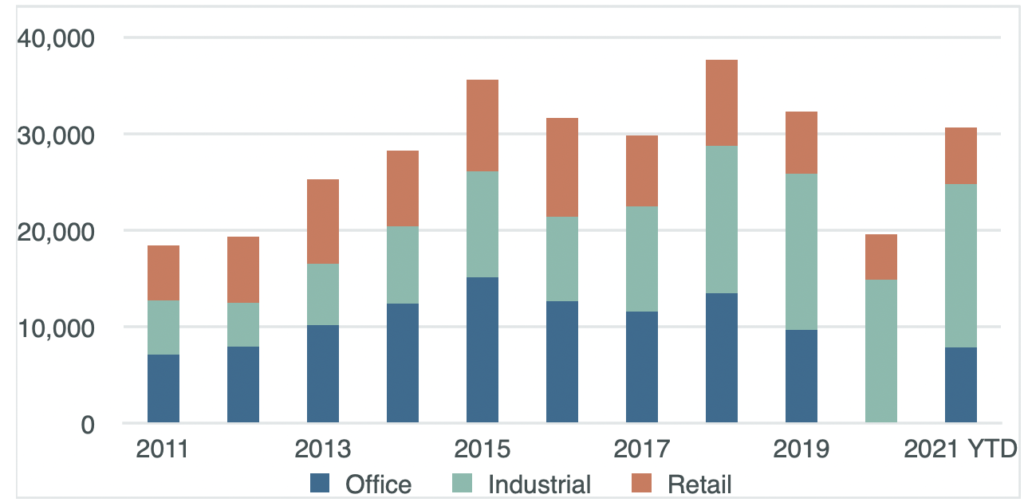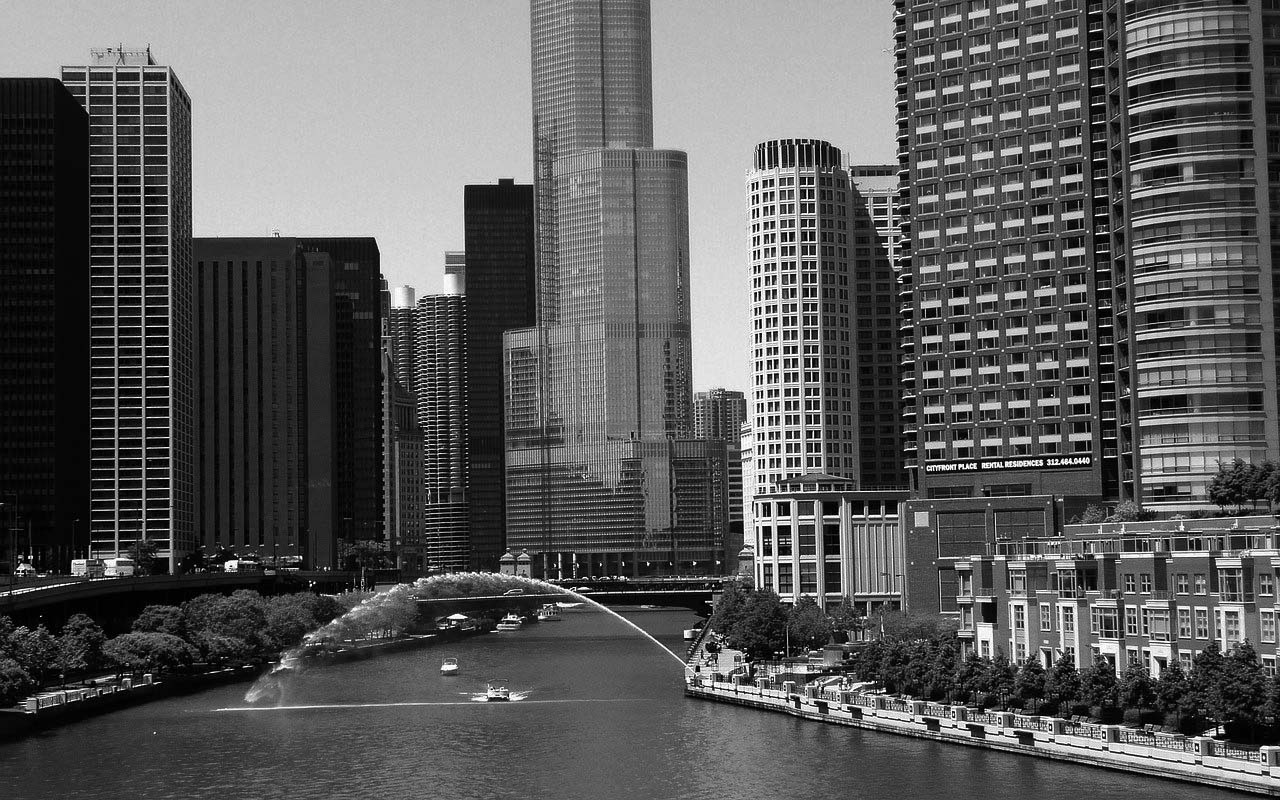The Midwest region is a broad geography encompassing the Great Lakes and upper Mississippi and Ohio River watersheds. Major cities in the area include well-known names like Chicago and Detroit, and fast-growing smaller cities like Minneapolis and Columbus, OH. While the region has long been valued for its stability in the face of volatile commercial real estate cycles, it continues to redefine itself as a geography that is both a pragmatic investment and a high-demand set of markets with surprising upside. Rather than a follower of coastal trends, the Midwest stands out for its steady fundamentals, abundance of land and national accessibility.
Booming industrial construction can’t keep up with demand
The Midwest industrial market continues to flourish with robust development and low vacancy rates. Rapid growth is being driven by third-party logistics, e-commerce, automotive, general retail, warehousing and food and beverage. To meet rising demand, occupiers are expanding by location and size of facilities.
Fueled largely by the rapid growth of e-commerce, Midwest industrial leasing surged 13.6% from 2019 to 2020. Activity has not slowed down, as evidenced by the first three quarters of 2021, where leasing volume has already reached 93% of the 2020 total. The leading markets for leasing activity this year include Chicago, with 49.8m sq ft, Indianapolis with 21.0m sq ft and Columbus with 19.2m sq ft.
Most large occupiers require state-of-the-art distribution facilities, which are driving an industrial construction boom. Midwest industrial construction deliveries have already reached 91% of the 2020 total through just the first three quarters of 2021. The average size of delivered distribution facilities increased by 55% from 2019 to 2021. Despite the amount of new construction being delivered, demand has continued to outpace supply. Vacancy rates decreased from 4.0% in Q3 2020 to 3.7% in Q3 2021 and rental rates grew 8.0% from Q3 2020 to Q3 2021.
The most important driver for logistics occupiers is labour, which is a far more significant cost factor than rent. Midwest markets are particularly well positioned with the ample skilled labour that logistics occupiers require. Rising transportation costs are also front of mind for occupiers and have increased the need for companies to establish distribution centres in the region. The location reduces the distance to major Midwest markets and allows companies to reach both coasts with a single distribution centre.
Nationally, industrial properties have become the preferred real estate sector for investors to place capital. Over the past several years, the Midwest has experienced a significant increase in capital returns, making it a region of choice for investors. It’s not uncommon for investors to receive a remarkable 10-12% investment return on Midwest industrial assets. From H2 2019 to H1 2021, average Midwest Class A stabilised industrial cap rates compressed 80 basis points (bps), finishing H1 2021 with an average range of 4.6% to 4.9%.
Office occupiers’ flight to quality and new
While the flight to quality for office tenants was well underway before 2020, the pandemic increased pressure on decision makers to reevaluate their space strategies moving forward. To maximise the value of their real estate footprints and give employees a compelling reason to make the commute to work in-person, many firms are upgrading their space. While some companies are reducing their overall footprint and moving toward a hybrid work strategy, the additional savings are allowing them to invest in spaces that boost employee engagement and retention.
An analysis of large office relocations in downtown Chicago since 1 April 2020 revealed that three out of every four tenants opted for offices that offered higher quality space in buildings that made significant investments in recent years – and tenants are willing to pay. While most large companies expect some level of reduction in the total size of their portfolio in the next three years, our evidence shows they still display a strong tendency towards premium space.
The labour forces found in key Midwest markets are among the nation’s most educated, which has made the region a headquarters magnet. Minneapolis boasts the most Fortune 500 companies per capita nationally and Chicago’s spent eight years as the No 1 US metro for corporate relocations and expansions. The Midwest’s low cost of living is a boon for both employers and employees – companies can reduce their salary burden while offering workers more bang for their buck than the same job on the coasts.
The diverse economies of the Midwest also bode well for the future of in-office work. Midwest markets command higher office occupancy rates compared with the coastal markets due to less propensity for virtual working given such diverse industry bases. While an increasing number of occupiers may move to a hybrid work model in the future, more manageable commute times across the Midwest and ample suburban stock with generous parking are beneficial tailwinds in encouraging office use.
Overall, office investment volume has trended down since the start of 2020, however stabilised Class A assets have continued to transact. Average stabilised Class A cap rates remained stable from H2 2019 to H1 2021 in the Midwest, with an average range of 7.5% to 8.3% as of H1 2021.
Retail offers yield and attractive barriers to entry
As pandemic mandates eased across the country earlier this year, many people still found themselves doing their shopping and dining at home. While this led to a major boom in e-commerce, home improvement, home furnishing and grocery retailers saw continued success in brick-and-mortar locations. Mobile commerce (m-commerce) also increased during this period and is expected to be 10% of total retail by 2025. Retailers’ mobile apps could benefit brick and mortar, as the purchases are often fulfilled in store.
Vacancy within Midwest shopping centres rose as the pandemic wore on, resulting in both temporary and permanent store closures. While vacancy reached a high of 7.9% in late 2020 into early 2021, it has since dropped down to 7.4%. Surprisingly, given the challenges of the pandemic, average asking rents have steadily climbed $0.63 per square foot since the beginning of 2019, moving from $11.37 per square foot to $12.00 per square foot. Although the number of retail centres currently under construction is roughly about half of what it was in the middle of 2019, the improving fundamentals may spur increased developer interest in the foreseeable future.
While single-tenant properties leased to high-credit tenants remained the investment of choice throughout the pandemic, large multi-tenant retail properties have come back into favour. The total number of retail properties sold increased 65.6% year-over-year from Q3 2020 to Q3 2021, with the total volume of dollars invested increasing 97% and the total square footage of retail traded increasing 89.0% over the same period. The average price per square foot increased by 3.7% and cap rates compressed, dropping 1.8 basis points. Investors and lenders are noticing and these fundamentals recently spurred the highest price per square foot ever paid on Oak Street, one of Chicago’s premiere high streets.
There is substantial evidence for optimism looking towards the future of the Midwest commercial real estate market. Industrial demand is expected to intensify in the coming years; office occupancy rates are trending upwards and many companies will be attracted by the cost savings opportunities of locating in the Midwest; and retail investment volume is trending upward with notable cap rates compression. Across the Midwest, average stabilised retail shopping centre Class A cap rates ranged from 6.9% to 7.7% as of H1 2021.
Midwest investment volume, past 10 years









